NCERT Solutions for Class 12 Maths Chapter 9 - Differential Equations - Exercise 9.6
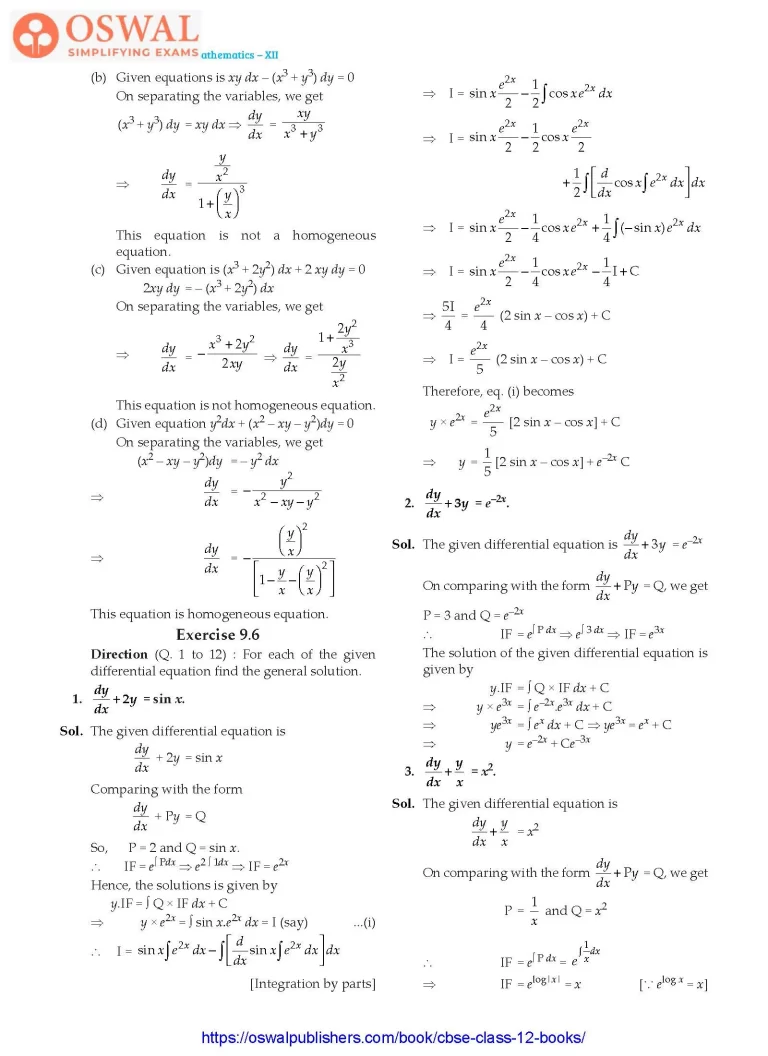
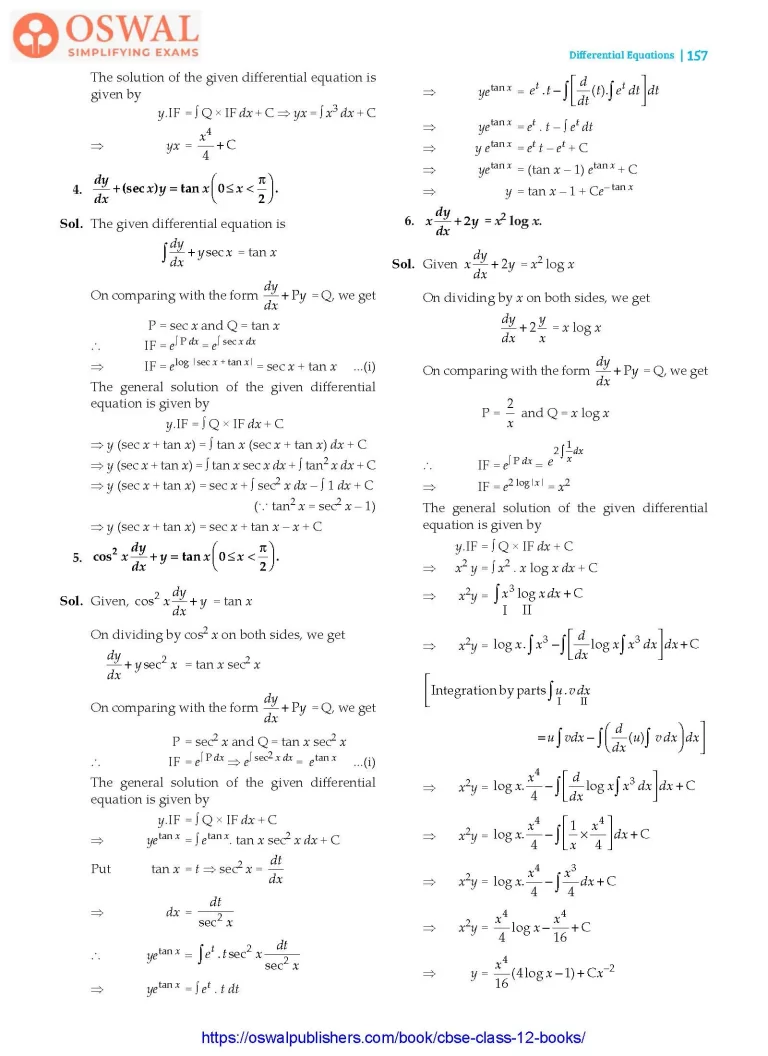
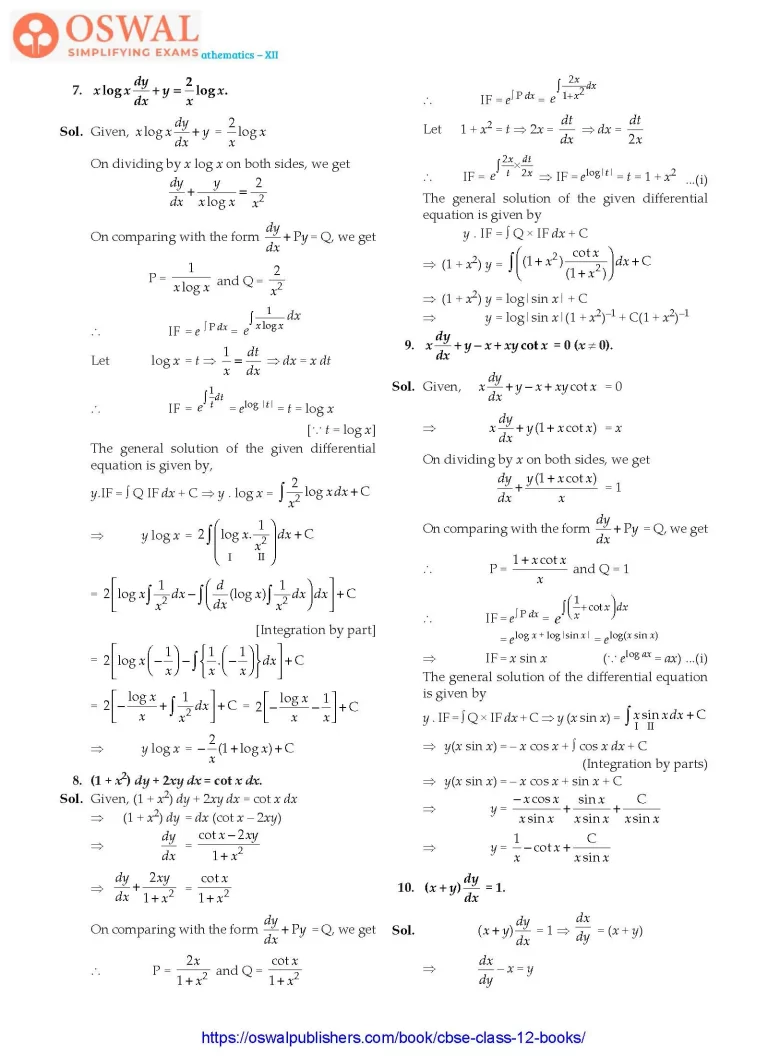
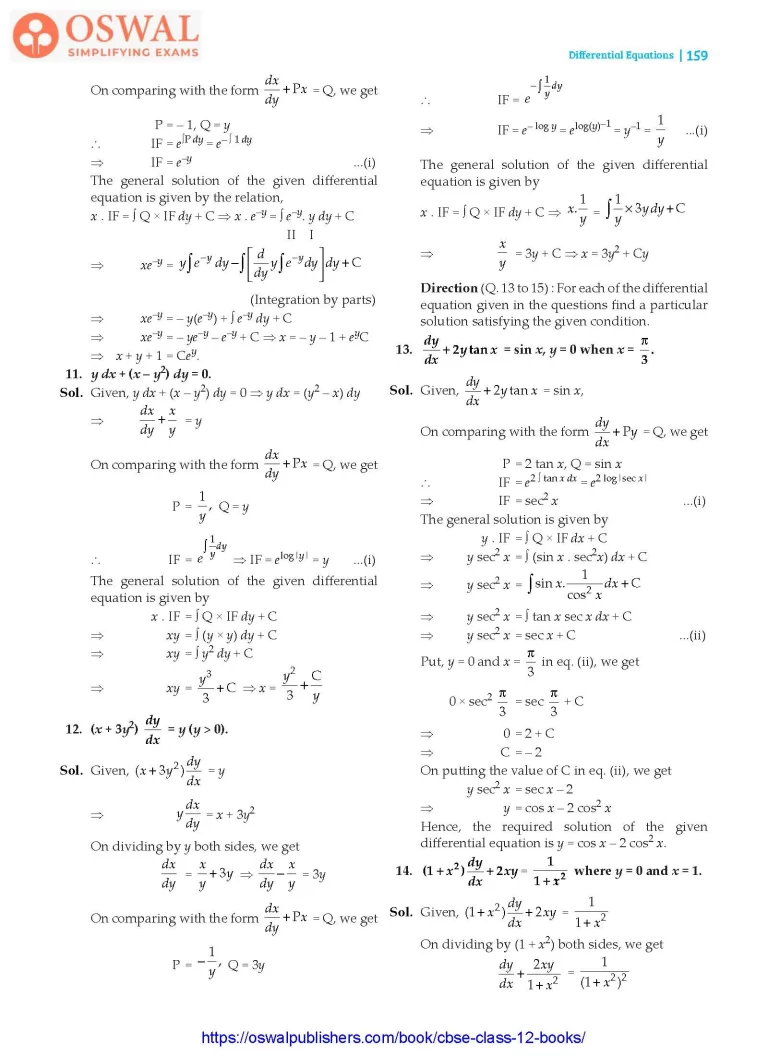
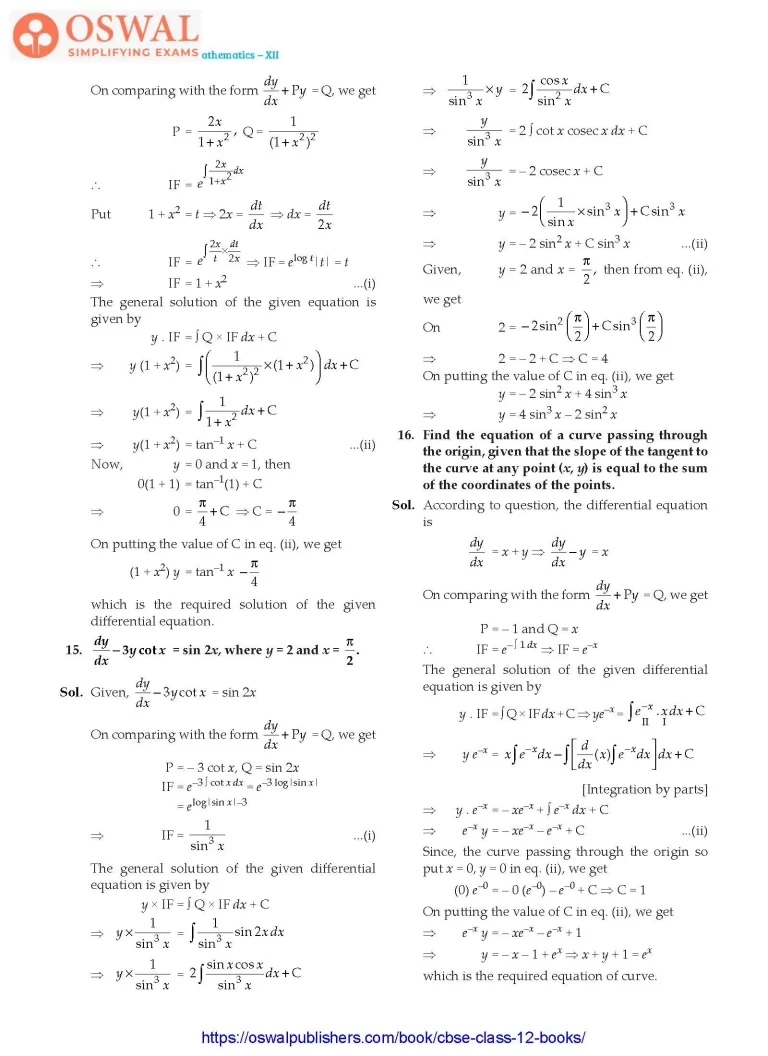
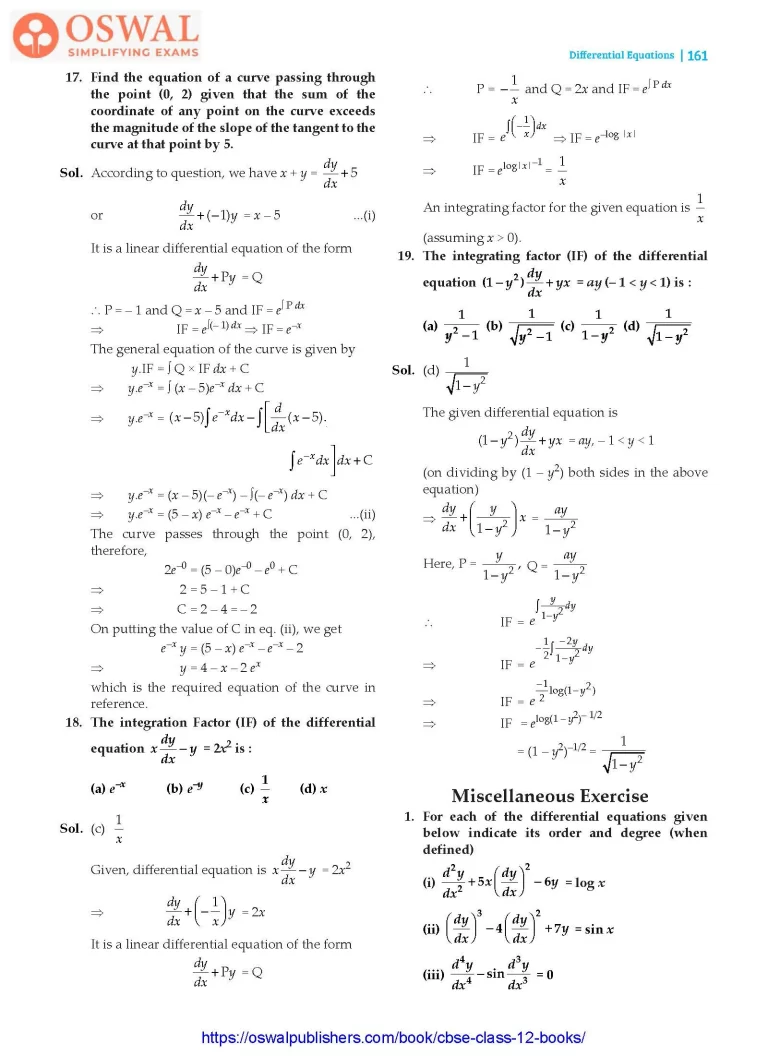
Access Exercises of Class 12 Maths Chapter 9 – Differential Equations
Exercise 9.1 Solutions 12 Questions
Exercise 9.2 Solutions 12 Questions
Exercise 9.3 Solutions 12 Questions
Exercise 9.4 Solutions 23 Questions
Exercise 9.5 Solutions 17 Questions
Exercise 9.6 Solutions 19 Questions
Miscellaneous Exercise on Chapter 9 Solutions 18 Questions
Exercise 9.6
Direction (Q. 1 to 12) : For each of the given differential equation find the general solution.
$$\textbf{1.\space}\frac{\textbf{dy}}{\textbf{dx}} \textbf{+ 2y = sin x.} $$
Sol. The given differential equation is
$$\frac{dy}{dx} + 2y = \text{sin x}\\\text{Comparing with the form}\\\frac{dy}{dx} + Py = \text{Q}$$
So, P = 2 and Q = sin x.
$$\therefore\space\text{IF} = e^{\int \text{P dx}}\Rarr\space e^{2\int dx}\\\Rarr\text{IF = e}^{2x}$$
Hence, the solutions is given by
$$y.\text{IF = }\int Q × \text{IF}\space dx + \text{C}\\\Rarr\space y×e^{2x} = \int\text{sin x. e}^{2x} dx = \text{I\space(say)}\\\text{...(i)}\\\therefore\space\text{ I = sin x}\int e^{2x} dx - \int\bigg[\frac{d}{dx}\text{sin x}\int e^{2x}dx\bigg]dx\\\lbrack\text{Integration by parts}\rbrack\\\Rarr\space \text{I = sin x}\frac{e^{2x}}{2} - \frac{1}{2}\int\text{cos x e}^{2x}dx\\\Rarr\space \text{I} = \text{sin x}\frac{e^{2x}}{2} - \frac{1}{2}\text{cos x}\frac{e^{2x}}{2} +\\\frac{1}{2}\int\bigg[\frac{d}{dx}\text{cos\space x}\int e^{2x}dx\bigg]dx$$
$$\Rarr\space\text{I = sin x}\frac{e^{2x}}{2} - \frac{1}{4}\text{cos}\space xe^{2x} +\\\frac{1}{4}\int(-\text{sin x})e^{2x}dx\\\Rarr\space\text{I = sin x}\frac{e^{2x}}{2} - \frac{1}{4}\text{cos x e}^{2x} - \frac{1}{4}\text{I + C}\\\Rarr\space \frac{5\text{I}}{4} = \frac{e^{2x}}{4}(\text{2 sin x - cos x}) + \text{C}\\\Rarr\space\text{I} = \frac{e^{2x}}{5}(\text{2 sin x - cos x}) + \text{C} $$
Therefore, eq. (i) becomes
$$y×e^{2x} = \frac{e^{2x}}{5}\lbrack\text{2 sin x - cos x}\rbrack + \text{C}\\\Rarr\space y =\frac{1}{5}\lbrack\text{2 sin x - cos x}\rbrack + e^{\normalsize-2x}+ \text{C}$$
$$\textbf{2.\space}\frac{\textbf{dy}}{\textbf{dx}} \textbf{+ 3y = e}^{\normalsize-\textbf{2x}}.$$
Sol. The given differential equation is
$$\frac{dy}{dx} + 3y = e^{\normalsize-2x}\\\text{On comparing with the form}\\\frac{dy}{dx} +\text{Py} = \text{Q,}\\\text{we get P = 3 and Q = e}^{\normalsize-2x}\\\therefore\space \text{IF =}\space e^{\int \text{P dx}}\\\Rarr e^{\int 3 dx}\\\Rarr\space \text{IF = e}^{3x}$$
The solution of the given differential equation is given by
$$y.\text{IF} = \int Q×\text{IF dx + C}\\\Rarr\space y × e^{3x} = \int e^{-2x}.e^{3x} dx + \text{C}\\\Rarr\space ye^{3x} = \int e^{x}dx + \text{C}\\\Rarr\space ye^{3x} = e^{x} + \text{C}\\\Rarr\space y = e^{\normalsize-2x} + \text{Ce}^{\normalsize-3x}$$
$$\textbf{3.\space}\frac{\textbf{dy}}{\textbf{dx}} + \frac{\textbf{y}}{\textbf{x}} \textbf{= x}^{\textbf{2}}\textbf{.}$$
Sol. The given differential equation is
$$\frac{dy}{dx} + \frac{y}{x} = x^{2}\\\text{On comparing with the form}\\\frac{dy}{dx} + \text{Py = Q,}\space\text{we get}\\\text{P} = \frac{1}{x}\space\text{and Q = x}^{2}\\\therefore\space\text{IF = e}^{\int \text{Pdx}} = e^{\int\frac{1}{x}dx}\\\Rarr\space \text{IF\space = e}^{\text{log}|x|} = x\\\lbrack\because\space e^{log \space x}=x\rbrack$$
The solution of the given differential equation is given by
$$y.\text{IF} = \int Q×\text{IF} dx + \text{C} \\\Rarr\space y x =\int x^{3} dx +\text{C}\\\Rarr\space yx = \frac{x^{4}}{4} + \text{C}$$
$$\textbf{4.\space}\frac{\textbf{dy}}{\textbf{dx}} + \textbf{(sec x)y} = \textbf{tan}\space\textbf{x}\bigg(0\leq x \leq\frac{\pi}{\textbf{2}}\bigg)\textbf{.}$$
Sol. The given differential equation is
$$\int\frac{dy}{dx} + \text{y sec x = tan x}\\\text{On comparing with the form}\\\space\frac{dy}{dx} + \text{Py = Q,}\space\text{we get}$$
P = sec x and Q = tan x
$$\therefore\space\text{IF = e}^{\text{P dx}} = e^{\int\text{sec x dx}}\\\Rarr\space\text{IF = e}^{\text{log}|\text{sec x + tanx }|}\\ = \text{sec x + tan x}\space\text{...(i)}$$
The general solution of the given differential equation is given by
$$y.\text{IF}= \int Q × \text{IF\space dx + C}\\\Rarr\space y(\text{sec x + tan x}) =\\ \int\text{tanx}(\text{sec x + tan x})dx + \text{C}\\\Rarr\space y(\text{sec x + tan x}) = \int\text{tan x sec x dx} + \\\int\text{tan}^{2}x dx + \text{C}\\\Rarr\space y(\text{sec x + tan x}) = \\\text{sec x} + \int \text{sec}^{2}dx - \int 1 dx\\(\because\space\text{tan}^{2}x = \text{sec}^{2}x-1)\\\Rarr\space y(\text{sec x + tan x}) = \\\text{sec x + tan x – x + C}$$
$$\textbf{5.\space cos}^{\textbf{2}}\frac{\textbf{dy}}{\textbf{dx}}\textbf{+ y = tan x}\\\bigg(\textbf{0}\leq \textbf{x} \leq\frac{\pi}{\textbf{2}}\bigg)\textbf{.}\\\textbf{Sol.\space}\text{Given, \space cos}^{2}x\frac{dy}{dx}+y =\text{tan x}$$
On dividing by cos2 x on both sides, we get
$$\frac{dy}{dx}+\text{y sec}^{2}x = \text{tan x sec}^{2}x\\\text{On comparing with the form}\\\frac{dy}{dx}+\text{Py = Q,\space}\text{we get}$$
P = sec2 x and Q = tan x sec2 x
$$\therefore\space\text{IF = }e^{\int \text{P dx}}\\\Rarr\space\int\text{sec}^{2}xdx = e^{\text{tan x}}\space\text{...(i)}$$
The general solution of the given differential equation is given by
$$y.\text{IF} = \int Q × \text{IF}\space dx + \text{C}\\\Rarr\space ye^{\text{tan x}} = \int e^{\text{tan x}} .\text{tan x sec}^{2}x \space dx + \text{C}\\\text{Put\space tan x = t}\\\Rarr\space\text{sec}^{2}x = \frac{dt}{dx}\\\Rarr\space dx = \frac{dt}{\text{sec}^{2}x}\\\therefore\space ye^{\text{tan x}} = \int e^{t}. t\text{sec}^{2}x\frac{dt}{\text{sec}^{2}x}\\\Rarr\space ye^{\text{tan x}} = \int e^{t}. t\space dt\\\Rarr\space ye^{\text{tan x}} = e^{t}.t -\int\bigg[\frac{d}{dt}(t).\int e^{t}dt\bigg]dt$$
$$\Rarr\space ye^{\text{tanx }} = e^{t}.t - \int e^{t} dt\\\Rarr\space y e^{\text{tan x}} = e^{t}t - e^{t} + \text{C}\\\Rarr\space ye^{\text{tan x}}= (\text{tan x-1})e^{\text{tan x}}+ \text{C}\\\Rarr\space y =\text{tan x-1} + \text{Ce}^{-\text{tan x}}$$
$$\textbf{6.\space}\textbf{x}\frac{\textbf{dy}}{\textbf{dx}} \textbf{+ 2y = x}^{\textbf{2}}\textbf{log x.}\\\textbf{Sol.\space}\text{Given\space}x \frac{dy}{dx}+2y = x^{2}\text{log x}$$
On dividing by x on both sides, we get
$$\frac{dy}{dx} + 2\frac{y}{x} = \text{x log x}$$
On comparing with the form
$$\frac{dy}{dx} + \text{Py = Q,}\space\text{we get}\\\text{P} = \frac{2}{x}\space\text{and Q = x log x}\\\therefore\space \text{IF = e}^{\int \text{P dx}} = e^{2\int\frac{1}{x}dx}\\\Rarr\space\text{IF = e}^{2 \space log|x|} = x^{2}$$
The general solution of the given differential equation is given by
$$\text{y.IF =}\int Q×\text{IF}\space dx + \text{C}\\\Rarr\space x^{2}y = \int x^{2}. \text{x log x dx + C}\\\Rarr\space x^{2}y = \int\underset{\text{I}}{x^{3}}\space\underset{\text{II}}{\text{log x dx}} + \text{C}\\\Rarr\space x^{2}y = log \space x.\int x^{3} -\\\int\bigg[\frac{d}{dx}\text{log x}\int x^{3}dx\bigg]dx + \text{C}\\\bigg[\text{Integrationbyparts}\int\underset{\text{I}}{u}.\underset{\text{II}}{v dx}\\= u\int v dx - \int\bigg(\frac{d}{dx}(u)\int v dx\bigg)dx\bigg]$$
$$\Rarr\space x^{2}y = \text{log x.}\frac{x^{4}}{4} -\\\int\bigg[\frac{d}{dx}\text{log x}\int x^{3}dx\bigg]dx + \text{C}\\\Rarr\space x^{2}y = \text{log x}.\frac{x^{4}}{4} -\int\bigg[\frac{1}{x}×\frac{x^{4}}{4}\bigg]dx + \text{C}$$
$$\Rarr\space x^{2}y = \text{log x}.\frac{x^{4}}{4} - \int\frac{x^{3}}{4}dx + \text{C}\\\Rarr\space x^{2}y = \frac{x^{4}}{4}\text{log x -}\frac{x^{4}}{16}+\text{C}\\\Rarr\space y = \frac{x^{4}}{16}(\text{4 log x-1}) + \text{Cx}^{\normalsize-2}$$
$$\textbf{7.\space x log x}\space\frac{\textbf{dy}}{\textbf{dx}} \textbf{+ y} = \frac{\textbf{2}}{\textbf{x}}\textbf{log x.}\\\textbf{Sol.\space} \text{Given,\space x log x}\frac{dy}{dx} + y \\= \frac{2}{x}\text{log x}$$
On dividing by x log x on both sides, we get
$$\frac{dy}{dx} + \frac{y}{\text{x log x}} = \frac{2}{x^{2}}\\\text{On comparing with the form}\\\frac{dy}{dx}+\text{Py = Q,}\space\text{we get}$$
$$\text{P = }\frac{1}{\text{x log x}}\text{and Q = }\frac{2}{x^{2}}\\\therefore\space \text{IF = e}^{\text{P dx}} = e^{\int\frac{1}{\text{x log x}}dx}\\\text{Let \space log x = t}\\\Rarr\space\frac{1}{x}=\frac{\text{dt}}{\text{dx}}\\\Rarr\space dx = x\space dt\\\therefore\space\text{IF} = e^{\int\frac{1}{t}dt} = e^{\text{log}|t|} = t = log x\\\lbrack\because\space\text{t = \text{log x}}\rbrack$$
The general solution of the given differential equation is given by,
$$\text{y. IF} = \int Q\space\text{IF}\space dx + \text{C}\\\Rarr\space \text{y . log x} =\int\frac{2}{x^{2}}\text{log x dx} + \text{C}\\\Rarr\space \text{y log x} = 2\int\bigg(\underset{\text{I}}{\text{log x}.}\underset{\text{II}}{\frac{1}{x^{2}}}\bigg)\text{ dx + C}\\ = 2\bigg[\text{log x}\int\frac{1}{x^{2}}dx - \\\int\bigg(\frac{d}{dx}\text{(log x)}\int\frac{1}{x^{2}}dx\bigg)dx\bigg]+\text{C}\\\lbrack\text{Integration by part}\rbrack \\= 2\bigg[\text{log x}\bigg(-\frac{1}{x}\bigg) - \\\int\begin{Bmatrix}\frac{1}{x}.\bigg(-\frac{1}{x}\bigg)\end{Bmatrix}dx\bigg]+ \text{C}$$
$$= 2\bigg[-\frac{\text{log x}}{x} + \int\frac{1}{x^{2}}dx\bigg] +\text{C}\\= 2\bigg[-\frac{\text{log x}}{x}-\frac{1}{x}\bigg]+\text{C}\\\Rarr\space\text{y log x} = -\frac{2}{x}(1 + \text{log x})+ \text{C}$$
8. (1 + x2) dy + 2xy dx = cot x dx.
Sol. Given, (1 + x2) dy + 2xy dx = cot x dx
$$\Rarr\space\frac{dy}{dx} = \frac{\text{cot x - 2xy}}{\text{1 + x}^{2}} \\\Rarr\space \frac{dy}{dx} + \frac{2xy}{1 + x^{2}} = \frac{\text{cot x}}{\text{1 + x}^{2}} $$
On comparing with the form
$$\frac{dy}{dx} + Py = Q,\space\text{we get}$$
$$\therefore\space\text{P} = \frac{2x}{1 + x^{2}}\text{and Q} = \frac{\text{cot x}}{\text{1 + x}^{2}}\\\therefore\space\text{IF = e}^{\int\text{P dx}} = e^{\int\frac{2x}{1+x^{2}}dx}\\\text{Let\space 1 +x}^{2}=t\Rarr\space 2x = \frac{dt}{dx}\\\Rarr dx = \frac{dt}{2x}\\\therefore\space \text{IF} = e^{\int\frac{2x}{t}×\frac{dt}{2x}}\\\Rarr\space \text{IF}=e^{\text{log}|t|}\\=t = 1 + x^{2}\space\text{...(i)}$$
The general solution of the given differential equation is given by
$$\text{y . IF} = \int Q × \text{IF}\space dx + \text{C}\\\Rarr\space (1 + x^{2})y = \\\int\bigg((1+x^{2})\frac{\text{cot x}}{(1+x^{2})}\bigg)dx+\text{C}\\\Rarr\space (1 + x^{2})y = \text{log}|\text{sin x}| + \text{C}\\\Rarr\space y = \text{log}|\text{sin x}|(1 + x^{2})^{\normalsize-1} + \text{C}(1 + x^{2})^{\normalsize-1} $$
$$\textbf{9.\space x}\frac{\textbf{dy}}{\textbf{dx}} \textbf{+ y-x + xycot x = 0}\textbf{(x}\neq\textbf{0).}\\\textbf{Sol.\space}\text{Given,}\space x\frac{dy}{dx} + y-x + xy \text{cot x} = 0\\\Rarr\space x\frac{dy}{dx} + y(1 + x cot x) = x$$
On dividing by x on both sides, we get
$$\frac{dy}{dx} + \frac{y(1 + \text{x cot x})}{x}=1\\\text{On comparing with the form}\\\frac{dy}{dx} + \text{Py = Q,}\space\text{we get}\\\therefore\space\text{P} = \frac{\text{1 + x cot x}}{x}\space\text{and Q = 1}\\\therefore\space \text{IF = e}^{\int P\space dx} = e^{\int\bigg(\frac{1}{x} + cot x\bigg)dx}\\ = e^{log x + log|\text{sinx}|} = e^{log(\text{x sin x})}\\\Rarr\space\text{IF} = x \space sin\space x\space(\because e^{log\space ax} = ax)\space\text{...(i)}$$
The general solution of the differential equation is given by
$$\text{y.IF} = \int \text{Q× IF}\space dx + \text{C}\\\Rarr\space y(x \space \text{sinx}) = \int\underset{\text{I}}{x}\underset{\text{II}}{\text{sinx\space dx + C}}\\\Rarr\space y(x\space sinx) =\\-x\space\text{cos x} + \int\text{cos x}\space dx +\text{C}\\(\text{Integration by parts})\\\Rarr\space\text{y(x sin x) = – x cos x + sin x + C}\\\Rarr\space y= \frac{- x\space cos x}{\text{x sin x}} + \frac{\text{sin x}}{\text{x sin x}}+\\\frac{\text{C}}{\text{x sin x}}\\\Rarr\space y = \frac{1}{x} - \text{cot x} + \frac{\text{C}}{\text{x sin x}}$$
$$\textbf{10.\space}\textbf{(x+y)}\frac{\textbf{dy}}{\textbf{dx}}\textbf{= 1.}\\\textbf{Sol.\space}(x+y)\frac{dy}{dx}=1\\\Rarr\space\frac{dx}{dy} = (x+y)\\\Rarr\space\frac{dx}{dy} - x=y\\\text{On comparing with the form}\\\frac{dx}{dy} + \text{Px = Q,}\space\text{we get}\\\text{P} =-1, \text{Q = y}\\\therefore\space\text{IF = e}^{\int\text{P dy}} = e^{-\int\text{1 dy}}\\\Rarr\space\text{IF = e}^{\normalsize-y}\space\text{...(i)}$$
The general solution of the given differential equation is given by the relation,
$$x .\text{IF =}\int Q× \text{IF}\space dy + \text{C}\\\Rarr\space x.e^{\normalsize-y} =\underset{\text{II}}{e^{\normalsize-y}}.\underset{\text{I}}{\text{y dy}+ \text{C}}\\\Rarr\space xe^{\normalsize-y} = y\int e^{\normalsize-y }dy - \\\int\bigg[\frac{d}{dy}y\int e^{-y}dy\bigg]dy + \text{C}$$
(Integration by parts)
$$\Rarr\space xe^{\normalsize-y} = -y(e^{\normalsize-y}) + \int e^{\normalsize-y} dy + \text{C}\\\Rarr\space xe^{\normalsize-y} =- ye^{-y} - e^{-y} + \text{C}\\\Rarr\space -y-1 + e^{y}C\\\Rarr\space x +y+1 = \text{Ce}^{y}.$$
11. y dx + (x – y2) dy = 0.
Sol. Given, y dx + (x – y2) dy = 0
$$\Rarr\space y \space dx = (y^{2}-x)dy\\\Rarr\space\frac{dx}{dy} + \frac{x}{y}=y\\\text{On comparing with the form}\\\frac{dx}{dy} + \text{Px = Q,}\space\text{we get}\\\text{P} = \frac{1}{y},\text{Q = Y}\\\therefore\space\text{IF = e}^{\frac{1}{y}dy} \\\Rarr\text{IF = e}^{\text{log}|y|}=y\space\text{...(i)} $$
The general solution of the given differential equation is given by
$$x.\text{IF} = \int Q × \text{IF dy + C}\\\Rarr\space xy = \int (y×y)dy +\text{C}\\\Rarr\space xy = \int y^{2}dy + \text{C}\\\Rarr\space xy = \frac{y^{3}}{3} + \text{C}\\\Rarr\space x = \frac{y^{2}}{3}+ \frac{\text{C}}{y}$$
$$\textbf{12.\space (x + 3y}^{\textbf{2}})\frac{\textbf{dy}}{\textbf{dx}} \textbf{= y}\textbf{(y}\gt \textbf{0).}\\\textbf{Sol.\space}\text{Given,}\space (x + 3y^{2})\frac{dy}{dx} = y\\\Rarr\space y\frac{dx}{dy} = x + 3y^{2}$$
On dividing by y both sides, we get
$$\frac{dx}{dy} = \frac{x}{y} + 3y\\\Rarr\space \frac{dx}{dy}-\frac{x}{y} = 3y\\\text{On comparing with the form}\space\\\frac{dx}{dy} + \text{Px = Q,\space}\text{we get}\\\text{P} = -\frac{1}{y},\text{Q = 3y}$$
$$\therefore\space\text{IF} = e^{-\int\frac{1}{y}dy}\\\Rarr\space \text{IF = e}^{-\text{log y} = }e^{\text{log}(y)^{\normalsize-1}} \\= y^{\normalsize-1}= \frac{1}{y}\space\text{...(i)}$$
The general solution of the given differential equation is given by
$$x .\text{IF} =\int Q × \text{IF}\space dy + \text{C}\\\Rarr\space x.\frac{1}{y} = \int\frac{1}{y}× 3ydy + \text{C}\\\Rarr\space \frac{x}{y} = 3y + \text{C}\\\Rarr\space x = 3y^{2} + \text{Cy}$$
Direction (Q. 13 to 15) : For each of the differential equation given in the questions find a particular solution satisfying the given condition.
$$\textbf{13.\space}\frac{\textbf{dy}}{\textbf{dx}} + \textbf{2y\space \text{tanx } = sinx,}\\\textbf{y = 0\space when x =}\frac{\pi}{\textbf{3}}\textbf{.}\\\textbf{Sol.\space}\text{Given,}\frac{dy}{dx} + \text{2y\space tan x = sinx,}\\\text{On comparing with the form}\\\frac{dy}{dx} + \text{Py = Q,}\space\text{we get}\\\text{P = 2 tan x, Q = sin x}\\\therefore\space \text{IF = e}^{2\int\text{tan x\space dx}} = e^{\text{2 log|sec x|}}\\\Rarr\space\text{IF = sec}^{2}x\space\text{...(i)}$$
The general solution is given by
$$y.\text{IF}= \int Q × \text{IF dx + C}\\\Rarr\space \text{y\space sec}^{2}x = \int (\text{sin x.sec}^{2}x)dx + \text{C}\\\Rarr\space \text{y\space sec}^{2}x =\int\text{sin x}.\frac{1}{\text{cos}^{2}x}\text{dx + C}\\\Rarr\space y\space\text{sec}^{2}x = \int\text{tan x sec x dx + C}\\\Rarr\space\text{y sec}^{2}x = \text{sec x + C}\space\text{...(ii)}\\\text{Put\space y = 0\space\text{and}\space x} = \frac{\pi}{3}\space\text{in eq.(ii),\space\text{we get}}\\ 0×\text{sec}^{2}\frac{\pi}{3} = \text{sec}\frac{\pi}{3} + \text{C}\\\Rarr\space 0 = 2 + \text{C}\\\Rarr\space \text{c = - 2}$$
On putting the value of C in eq. (ii), we get
y sec2 x = sec x – 2
$$\Rarr\space y = \text{cos x - 2\space cos}^{2}x$$
Hence, the required solution of the given differential equation is y = cos x – 2 cos2 x.
$$\textbf{14.\space}\textbf{(1 + x})^{\textbf{2}}\frac{\textbf{dy}}{\textbf{dx}} \textbf{+ 2xy =}\frac{\textbf{1}}{\textbf{1+x}^{\textbf{2}}}\\\textbf{where\space y= 0 and x = 1.}\\\textbf{Sol.\space}\text{Given\space}(1 + x^{2})\frac{dy}{dx} + 2xy=\\\frac{1}{1 + x^{2}}$$
On dividing by (1 + x2) both sides, we get
$$\frac{dy}{dx} + \frac{2xy}{1+ x^{2}} = \frac{1}{(1 + x^{2})^{2}}\\\text{On comparing with the form}\space\\\frac{dy}{dx} + \text{Py = Q,}\space\text{we get}\\\text{P}=\frac{2x}{1+x^{2}},\text{Q} = \frac{1}{(1 + x^{2})^{2}}\\\therefore\space\text{IF = e}^{\int\frac{2x}{1 + x^{2}}dx}\\\text{Put \space 1 + x}^{2} = t\Rarr\space 2x = \frac{dt}{dx}\\\Rarr\space dx = \frac{dt}{2x}\\\therefore\space\text{IF = e}^{\int\frac{2x}{t}×\frac{dt}{2x}}\\\Rarr\space \text{IF = e}^{\text{log t}}|t|=t\\\Rarr\space\text{IF = }\text{1 + x}^{2}\space\text{...(i)}$$
The general solution of the given equation is given by
$$y.\space\text{IF} =\int Q×\text{IF\space dx + C}\\\Rarr\space y(1 + x^{2}) = \\\int\bigg(\frac{1}{(1+x^{2})^{2}}×(1+x^{2})\bigg)dx + \text{C}\\\Rarr\space y(1 + x^{2}) =\int\frac{1}{1 + x^{2}}dx + \text{C}\\\Rarr\space y(1 + x^{2}) = \text{tan}^{\normalsize-1}x + \text{C}\space\text{...(ii)}$$
Now, y = 0 and x = 1, then
0(1 + 1) = tan–1(1) + C
$$\Rarr\space 0 = \frac{\pi}{4} + \text{C}\\\Rarr\space \text{C = -}\frac{\pi}{4}$$
On putting the value of C in eq. (ii), we get
$$(1 + x^{2})y = \text{tan}^{\normalsize-1}x - \frac{\pi}{4}$$
which is the required solution of the given differential equation.
$$\textbf{15.\space}\frac{\textbf{dy}}{\textbf{dx}}\textbf{\space - 3y cot x = sin 2x,\space}\\\textbf{where y = 2 and x} \textbf{=} \frac{\pi}{\textbf{2}}\textbf{.}\\\textbf{Sol.\space}\text{Given\space}\frac{dy}{dx}- \text{3y cot x = sin 2x}\\\text{On comparing with the form}\\\frac{dy}{dx} + \text{Py = Q,\space}\text{we get}$$
P = – 3 cot x, Q = sin 2x
$$\text{IF = e}^{\normalsize-3 \int cot x\space dx} = e^{-3 \space log|\text{sinx}|}\\ = e^{\text{log}|\text{sin x}|-3}\\\Rarr\space \text{IF = }\frac{1}{\text{sin}^{3}x}\space\text{...(i)}$$
The general solution of the given differential equation is given by
$$y × \text{IF = }\int Q ×\text{IF}\space\text{dx + C}\\\Rarr\space y×\frac{1}{\text{sin}^{3}x} = \int\frac{1}{\text{sin}^{3}x}\text{sin 2x dx}\\\Rarr\space y×\frac{1}{\text{sin}^{3}x} = 2\int\frac{\text{sin x cos x }}{\text{sin}^{3}x}dx + \text{C}$$
$$\Rarr\space\frac{1}{\text{sin}^{3}x}×y = 2\int\frac{\text{cos x}}{\text{sin}^{2}x}dx + \text{C}\\\Rarr\space \frac{y}{\text{sin}^{3}x} = 2\int\text{cot x cose x dx + C}\\\Rarr\space \frac{y}{\text{sin}^{3}x} =-2\text{cosec x + C}\\\Rarr\space y =-2\bigg(\frac{1}{\text{sin x}}×\text{sin}^{3}x\bigg) + \text{C sin}^{3}x\\\Rarr\space y =-2\text{sin}^{2}x + \text{C sin}^{3}x\space\text{...(ii)}\\\text{Given, y=2 and x =}\frac{\pi}{2},\space\text{then from eq. (ii), we get}\\\text{on\space} 2 = -2\text{sin}^{2}\bigg(\frac{\pi}{2}\bigg) + \text{C sin}^{3}\bigg(\frac{\pi}{2}\bigg) $$
$$\Rarr\space 2 = -2 + \text{C}\space\Rarr\space \text{C = 4} $$
On putting the value of C in eq. (ii), we get
y = – 2 sin2 x + 4 sin3 x
$$\Rarr\space y = 4\space\text{sin}^{3}x - 2\space \text{sin}^{2}x$$
16. Find the equation of a curve passing through the origin, given that the slope of the tangent to the curve at any point (x, y) is equal to the sum of the coordinates of the points.
Sol. According to question, the differential equation is
$$\frac{dy}{dx} = x+y\\\Rarr\space \frac{dy}{dx}-y = x\\\text{On comparing with the form}\\\frac{dy}{dx} +\text{Py = Q,}\space\text{we get}$$
P = – 1 and Q = x
$$\therefore\space\text{IF = e}^{-\int 1 dx}\\\Rarr\space e^{\normalsize-x}$$
The general solution of the given differential equation is given by
$$y.\text{IF} = \int Q × \text{IF}\space dx + \text{C}\\\Rarr\space ye^{-x} = \int\underset{\text{II}}{e^{-x}.}\underset{\text{I}}{x}dx + \text{C}$$
$$\Rarr\space ye^{\normalsize-x} = x\int e^{\normalsize-x}dx -\\\int\bigg[\frac{d}{dx}(x)\int e^{\normalsize-x}dx\bigg]dx + \text{C}\\\lbrack\text{Integration by parts}\rbrack\\\Rarr\space y.e^{\normalsize-x}= -xe^{\normalsize-x} + \int e ^{\normalsize -x} dx + \text{C}\\\Rarr\space e^{\normalsize-x} y = -xe^{\normalsize-x} - e^{\normalsize-x} + \text{C}\space\text{...(ii)}$$
Since, the curve passing through the origin so put x = 0, y = 0 in eq. (ii), we get
$$(0)e^{\normalsize-0} = - 0(e^{\normalsize-0})-e^{\normalsize-0} + \text{C}\\\Rarr\space\text{C = 1}$$
On putting the value of C in eq. (ii), we get
$$\Rarr\space e^{\normalsize-x}y = xe^{\normalsize-x} - e^{\normalsize-x} + 1\\\Rarr\space y = -x-1 + e^{x}\\\Rarr\space x+y+1 = e^{x}$$
which is the required equation of curve.
17. Find the equation of a curve passing through the point (0, 2) given that the sum of the coordinate of any point on the curve exceeds the magnitude of the slope of the tangent to the curve at that point by 5.
Sol. According to question,
$$\text{we have x + y} = \frac{dy}{dx} + 5\\\text{or\space}\frac{dy}{dx} + (\normalsize-1)y = x-5\space\text{...(i)}$$
It is a linear differential equation of the form
$$\frac{dy}{dx} + \text{Py = Q}\\\therefore\space\text{P = -1 and Q = x - 5\space\\ and}\\\text{IF = e}^{\int \text{P dx}}\\\Rarr\space \text{IF = e}^{\int(\normalsize-1)dx}\\\Rarr\space \text{IF = e}^{\normalsize-x}$$
The general equation of the curve is given by
$$y.\text{IF} = \int Q × \text{IF}\space dx + \text{C}\\\Rarr\space y.e^{\normalsize-x} = \int(x-5)^{e^{\normalsize-x}} dx + \text{C}\\\Rarr\space y.e^{-x} = (x-5)\int e^{\normalsize-x} dx-\\\int\bigg[\frac{d}{dx}(x-5).\int e^{\normalsize-x}dx\bigg]dx + \text{C}\\\Rarr\space y.e^{\normalsize-x} = (x-5)(-e^{\normalsize-x}) - \int(-e^{\normalsize-x})dx + \text{C}\\\Rarr\space y.e^{\normalsize-x} = (5 - x)e^{\normalsize-x} - e^{\normalsize-x} + \text{C}\space\text{...(ii)}$$
The curve passes through the point (0, 2), therefore,
2e–0 = (5 – 0)e–0 – e0 + C
$$\Rarr\space 2 = 5 - 1 + \text{C}\\\Rarr\space\text{C} = 2-4=-2$$
On putting the value of C in eq. (ii), we get
e–x y = (5 – x) e–x – e–x – 2
$$\Rarr\space y = 4-x-2 e^{x}$$
which is the required equation of the curve in reference.
18. The integration Factor (IF) of the differential equation
$$\textbf{x}\frac{\textbf{dy}}{\textbf{dx}}\textbf{- y = 2x}^{\textbf{2}}\space\textbf{is:}\\\textbf{(a)\space e}^{\normalsize-x}\\\textbf{(b)\space e}^{\normalsize-y}\\\textbf{(c)\space}\frac{\textbf{1}}{\textbf{x}}$$
(d) x
$$\textbf{Sol.\space}\space\frac{1}{x}\\\text{Given, differential equation is}\\x\frac{dy}{dx}-y = 2x^{2}\\\Rarr\space \frac{dy}{dx} + \bigg(-\frac{1}{x}\bigg)y = 2x$$
It is a linear differential equation of the form
$$\frac{dy}{dx} + \text{Py = Q}\\\therefore\space\text{P} =-\frac{1}{x}\space\text{and Q = 2x and}\\\text{ IF = e}^{\int\text{P dx}}\\\Rarr\space \text{IF = e}^{\int\bigg(\frac{1}{x}\bigg)dx}\\\Rarr\space\text{IF = e}^{-\text{log}|x|}\\\Rarr\space\text{IF = e}^{\text{log}|x|^{\normalsize-1}} = \frac{1}{x}$$
An integrating factor for the given equation is
$$\frac{1}{x}\\\text{(assuming \space x}\gt 0).$$
19. The integrating factor (IF) of the differential equation
$$\textbf{(}\textbf{1 - y}^{\textbf{2}}\textbf{)}\frac{\textbf{dy}}{\textbf{dx}} \textbf{+ yx = ay (-1}\lt \textbf{y}\lt 1\textbf{)}\space\textbf{is\space:}$$
$$\textbf{(a)\space}\frac{\textbf{1}}{\textbf{y}^{\textbf{2}}\textbf{-1}}\\\textbf{(b)\space}\frac{1}{\sqrt{\textbf{y}^{\textbf{2}}\textbf{-1}}}\\\textbf{(c)\space}\frac{\textbf{1}}{\textbf{1-y}^{2}}\\\textbf{(d)\space}\frac{\textbf{1}}{\sqrt{\textbf{1 - y}^{2}}}\\\textbf{Sol.\space}\frac{1}{\sqrt{\text{1 - y}^{2}}}$$
The given differential equation is
$$\text{(1-y)}^{2}\frac{dy}{dx} + yx = ay,\\-1\lt y\lt 1$$
(on dividing by (1 – y2) both sides in the above equation)
$$\Rarr\space\frac{dy}{dx} + \bigg(\frac{y}{\text{1 - y}^{2}}\bigg)x = \frac{\text{xy}}{1 - y^{2}}\\\text{Here, P} = \frac{y}{\text{1 - y}^{2}}, Q = \frac{\text{ay}}{\text{1 - y}^{2}}\\\therefore\space \text{IF} = e^{\int\frac{y}{\text{1 - y}^{2}}}dy\\\Rarr\space \text{IF = e}^{-\frac{1}{2}\int\frac{\normalsize-2y}{\text{1 - y}^{2}}dy}\\\Rarr\space \text{IF = e}^{\frac{\normalsize-1}{2}\text{log}}(1 - y^{2})\\\Rarr\space \text{IF = e}^{\text{log}}(\text{1 - y}^{2})^{-\frac{1}{2}}\\=(1-y^{2})^{\frac{\normalsize -1}{2}} = \frac{1}{\sqrt{1 - y^{2}}}$$
